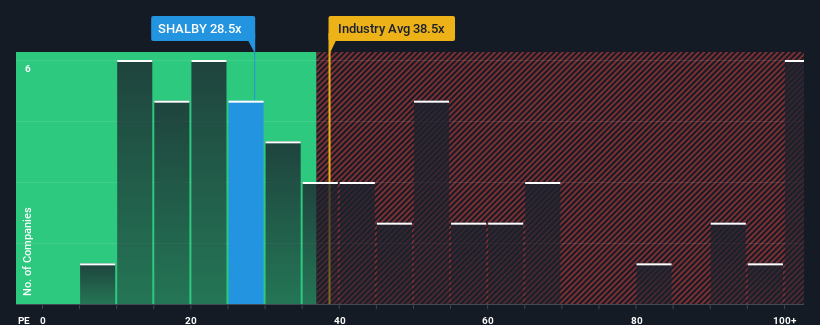- India
- /
- Healthcare Services
- /
- NSEI:SHALBY
Market Cool On Shalby Limited's (NSE:SHALBY) Earnings Pushing Shares 26% Lower

Shalby Limited (NSE:SHALBY) shareholders that were waiting for something to happen have been dealt a blow with a 26% share price drop in the last month. Still, a bad month hasn't completely ruined the past year with the stock gaining 71%, which is great even in a bull market.
Even after such a large drop in price, there still wouldn't be many who think Shalby's price-to-earnings (or "P/E") ratio of 28.5x is worth a mention when the median P/E in India is similar at about 29x. Although, it's not wise to simply ignore the P/E without explanation as investors may be disregarding a distinct opportunity or a costly mistake.
Earnings have risen firmly for Shalby recently, which is pleasing to see. It might be that many expect the respectable earnings performance to wane, which has kept the P/E from rising. If you like the company, you'd be hoping this isn't the case so that you could potentially pick up some stock while it's not quite in favour.
Check out our latest analysis for Shalby

What Are Growth Metrics Telling Us About The P/E?
In order to justify its P/E ratio, Shalby would need to produce growth that's similar to the market.
Taking a look back first, we see that the company grew earnings per share by an impressive 27% last year. Pleasingly, EPS has also lifted 429% in aggregate from three years ago, thanks to the last 12 months of growth. Accordingly, shareholders would have probably welcomed those medium-term rates of earnings growth.
Weighing that recent medium-term earnings trajectory against the broader market's one-year forecast for expansion of 24% shows it's noticeably more attractive on an annualised basis.
With this information, we find it interesting that Shalby is trading at a fairly similar P/E to the market. It may be that most investors are not convinced the company can maintain its recent growth rates.
What We Can Learn From Shalby's P/E?
With its share price falling into a hole, the P/E for Shalby looks quite average now. It's argued the price-to-earnings ratio is an inferior measure of value within certain industries, but it can be a powerful business sentiment indicator.
Our examination of Shalby revealed its three-year earnings trends aren't contributing to its P/E as much as we would have predicted, given they look better than current market expectations. When we see strong earnings with faster-than-market growth, we assume potential risks are what might be placing pressure on the P/E ratio. It appears some are indeed anticipating earnings instability, because the persistence of these recent medium-term conditions would normally provide a boost to the share price.
Before you settle on your opinion, we've discovered 1 warning sign for Shalby that you should be aware of.
Of course, you might also be able to find a better stock than Shalby. So you may wish to see this free collection of other companies that have reasonable P/E ratios and have grown earnings strongly.
If you're looking to trade Shalby, open an account with the lowest-cost platform trusted by professionals, Interactive Brokers.
With clients in over 200 countries and territories, and access to 160 markets, IBKR lets you trade stocks, options, futures, forex, bonds and funds from a single integrated account.
Enjoy no hidden fees, no account minimums, and FX conversion rates as low as 0.03%, far better than what most brokers offer.
Sponsored ContentNew: Manage All Your Stock Portfolios in One Place
We've created the ultimate portfolio companion for stock investors, and it's free.
• Connect an unlimited number of Portfolios and see your total in one currency
• Be alerted to new Warning Signs or Risks via email or mobile
• Track the Fair Value of your stocks
Have feedback on this article? Concerned about the content? Get in touch with us directly. Alternatively, email editorial-team (at) simplywallst.com.
This article by Simply Wall St is general in nature. We provide commentary based on historical data and analyst forecasts only using an unbiased methodology and our articles are not intended to be financial advice. It does not constitute a recommendation to buy or sell any stock, and does not take account of your objectives, or your financial situation. We aim to bring you long-term focused analysis driven by fundamental data. Note that our analysis may not factor in the latest price-sensitive company announcements or qualitative material. Simply Wall St has no position in any stocks mentioned.
About NSEI:SHALBY
Shalby
Engages in the operation of multi-specialty hospitals primarily in India, the United States, Japan, Indonesia, Oman, the United Arab Emirates, Bangladesh, Nepal, and internationally.
Reasonable growth potential with adequate balance sheet.
Market Insights
Community Narratives




